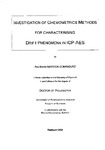INVESTIGATION OF CHEMOMETRICS METHODS FOR CHARACTERISING DRIFT PHENOMENA IN iCK-AES
| dc.contributor.author | MARCOS-DOMINGUEZ, ANA MARIA | |
| dc.contributor.other | Faculty of Science and Engineering | en_US |
| dc.date.accessioned | 2013-09-13T09:16:56Z | |
| dc.date.available | 2013-09-13T09:16:56Z | |
| dc.date.issued | 2001 | |
| dc.identifier | NOT AVAILABLE | en_US |
| dc.identifier.uri | http://hdl.handle.net/10026.1/1679 | |
| dc.description.abstract |
The objective of this study was to fully characterise drift phenomena in inductively coupled plasma atomic emission spectroscopy (ICP-AES) in order to develop novel correction procedures to aid routine analysis. Long-term drift of the analytical signal continues to be a potential disadvantage when using ICP-AES and often necessitates regular recalibration. The long-term stability of three commercially available Instruments was studied using In each case a range of analyte and intrinsic plasma emission lines. Long-term fluctuations were observed which generated drift bias of up to 20% on the initial values. The drift pafterns were characterised and found to be qualitatively reproducible. In most cases, similar long-term fluctuations were observed independent of the analyte or nature of the emission line. In addition, high inter-element correlation was observed on the long-term fluctuations even when sequential acquisition was employed. In order to study the fundamental causes of drift, the effect of two key instrumental parameters, i.e. the RF power and the nebutiser gas flow rate were studied with respect to the stability of the signal. Different drift patterns were found depending on the working conditions. Classical statistical methods and a multi-way approach. PARAFAC. were then employed to describe the system. The use of intemal standards to correct for drift has also been investigated, but found to be of benefit only under certain defined conditions (i.e. robust conditions, high RF power and low nebuliserflow rate). At soft conditions, low RF power and medium to high nebuliser flow rate, the system Is very unstable and intemal standardisation is not fully effective as a correction method. For such conditions, a novel correction procedure has been developed, which employs the drift pattem of one intrinsic plasma line (i.e. an argon line) and a correction factor which is specific for each emission line. The drift values were reduced from around 20% before correction to better than ±2% following the described protocol. Finally, the effects of chemical matrices on the long-term stability of the emission signals have been evaluated. Three synthetic matrices were prepared simulating nitric, soil and water matrices. The stability of the instrument when working wrth these matrices at both robust and soft conditions was found to be poor, especially when the solution was matched with the soil matrix. The use of more robust conditions did not improve the long-temi stability of the emission signals. The outcome of this study proved to be a better understanding of drift phenomena and a novel method for drift correction. | en_US |
| dc.description.sponsorship | BRITISH GEOLOGICAL SURVEY | en_US |
| dc.language.iso | en | en_US |
| dc.publisher | University of Plymouth | en_US |
| dc.title | INVESTIGATION OF CHEMOMETRICS METHODS FOR CHARACTERISING DRIFT PHENOMENA IN iCK-AES | en_US |
| dc.type | Thesis | |
| plymouth.version | Full version | en_US |
| dc.identifier.doi | http://dx.doi.org/10.24382/3403 |
Files in this item
This item appears in the following Collection(s)
-
01 Research Theses Main Collection
Research Theses Main


